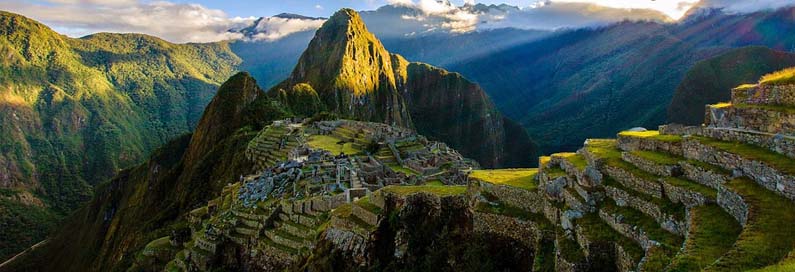Highlights
of a Peru Vacation
Overview
of Peru for Travelers
Shamans
of Peru CD
Things
to Do in Nazca, Peru
Take
an adventure trip to the Peruvian Amazon
The
Peruvian Paso Horse
Choquequirao – the Real Lost
City of the Inca by Alex
Hundreds of thousands come back
from Peru unaware that just about 100 km or so from Machu Picchu lies another
magnificent complex. Choquequirao has taken over from over-crowded Machu
Picchu as the true Lost City of the Inca.
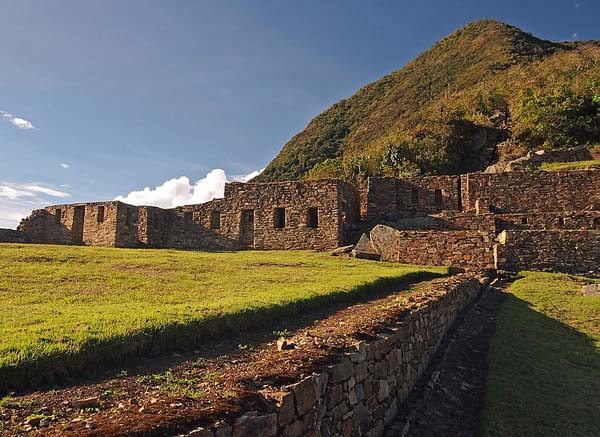
Photo by McGhiever
Choquequirao: 3030
m altitude, 60 km round-trip over 5 days, transport: none, terrain: gorgeous.
Choquequirao was actually
first discovered way before Machu Picchu. However, it is less preserved
and the excavation works are more recent. To date, only about 30% of it
has been recovered – mainly the top (and most important) part. The slopes
are still largely buried. How does it compare to Machu Picchu, I hear you
ask. Well, it doesn’t. They are different cities altogether. Choquequirao
is built very differently, more conventionally.
Palaces, religious structures,
living quarters and military constructions surround the ample main square.
Many of the buildings are 2-3 stories.
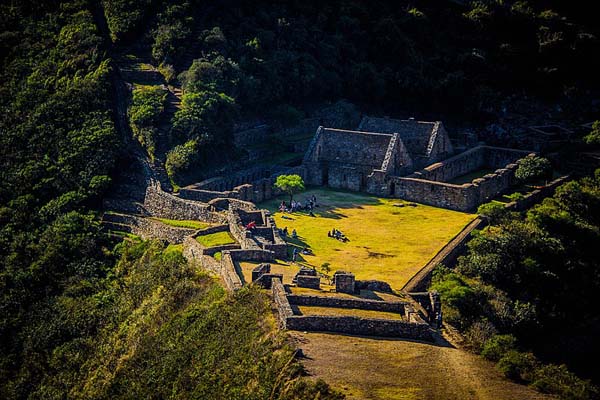
Photo by Ozesama
The city is dominated by
a magnificent ceremonial hill with the top chopped off and turned into
a religious arena and an observatory (6 of the peaks and 2 of the rivers
sacred to the Inca can be viewed from here). The slopes hold a vast number
of structures, from simple shacks to well-preserved large agricultural
terraces. The overall area covered by Choquequirao is 1810 hectares, much
bigger than that of Machu Picchu.
Choquequirao is more than
just a pretty face. They call it a sister of Machu Picchu, I would call
it a brother. While the Virgins of the Moon were dancing around in MP,
Choquequirao kept everyone fed and safe – it was the administrative, military
and economic centre of the whole area, as well as a bearer of a strong
religious significance. Choquequirao is where the remnants of the Inca
had their last days.
The archaeological work here
is slow due to inaccessibility and low funding, but it seems that what
they do find makes Choquequirao more and more significant every year.
Choquequirao is a genuinely
lost city. Harshly inaccessible from either side, it is no wonder it never
got discovered (even in our days of New-age Machu Picchu worship). This
little corner of paradise is firmly locked by the guardian mountains. They
isolate this spot from the whole world, like a ring a soundproof padding.
There is only the low-flying condor and the rainbow reaching the city from
the bottom of the valley. We could almost touch that rainbow.
But that’s still not the
best thing about Choquequirao. Lost in the middle of nowhere, surrounded
by silent mountains, it was absolutely empty. And with that comes freedom.
There was an invisible team of archaeologists somewhere, my guide Victor,
Felipe and Rolando (two Austrian guys I came with), and an English / Peruvian
explorer with his loyal Sancho Panza. Yet it was still the end of the high
season. No ticket booth, no security, no supervision, not even a toilet.
It was all up to our ethics. We were not on a tour, we were guests here
– the camping ground was on one of the terraces. We wandered wherever we
wanted (respecting the archaeological restrictions), day or night. Choque
is particularly magic after nightfall, if you have the guts. It’s not for
the faint-hearted to walk around the ruins surrounded by wilderness, hearing
whispers of ghosts and wondering which sacred grounds you are trespassing.
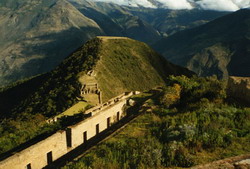 The
reason we could have a Lost City all to ourselves was because there was
no train. You had to beat the trail for two days, and it was not all a
Sunday promenade. The
reason we could have a Lost City all to ourselves was because there was
no train. You had to beat the trail for two days, and it was not all a
Sunday promenade.
The starting point is Cachora,
a charming sleepy village at the bottom of a valley. A bus from Cuzco drops
you off just before it gets to Abancay. You have to spiral downwards for
two hours to get to the village.
Once there, things were easy
to find. Cachora is the mule depot of the mountain range. There is a pretty
basic hotel, a basic place to eat some potatoes or soup, and a basic shop
to buy basic provisions. Water is not essential if you have purifying tablets
– you will come across many springs on the way. I’m not sure, but I think
they pretty much pull whatever villager is available when you ask for a
guide. They are all good anyway. Our guide for the trek was Victor – a
farmer who had done the 7-day trek to Santa Teresa 12 times. Luigi (my
buddy) and me also rented two mules: one for the backpacks and one for
riding, if required.
The first day is a
gradual shedding of civilisation. We went through the village, kids running
after us, adults smiling and wishing good luck. Then some farmland with
an occasional campesino. Then an abandoned hacienda and a short forest
trail, and, finally, the mountains.
For three hours or so it
was a leisurely promenade on a wide flat trail. The serenity…just the birds,
the sun and the peaks bathed in sunlight. The road wound round the bends
like a box of chocolates: at every corner a new view, more impressive than
the one before. A wall on the left, a drop on the right, and a bunch of
summits as far as the eye can see.
Later, the soil changed from
grey rocks to red powder and we began our descent into the Apurimac river
valley. We reached the Chiquisca camping station right in time for the
dark. It was no more than a cleared patch of wood, 20 m in diameter, looked
after by a 14 year old girl living there in almost total solitude. That
was the most institutionalised accommodation we were to encounter for the
rest of the trail.
We woke up in the clouds,
literally. They were all around us. You could wash your face in them. Our
guide took us to the edge of a cliff and pointed out the task for the day.
A vertical wall going all the way into the sky, the trail a thin cord zigzagging
schizophrenically over its face like a crack. It looked totally intimidating.
But first we had to come down into the valley and cross the Apurimac river
that separated us from the wall.
So we did, slowly, savouring
the stereotypical scorched cactus scenery of the valley. The bridge was
modern and strong (I guess the government attended to that in search
of some tourist revenue). Finally, the ascent: 3 hours of mind-numbing
grunt work. Left, push, right, push, left, push, right, push. Water was
going by the gallons. But the views were unobstructed and once you detach
from the physical effort you mind floats in the mountains.
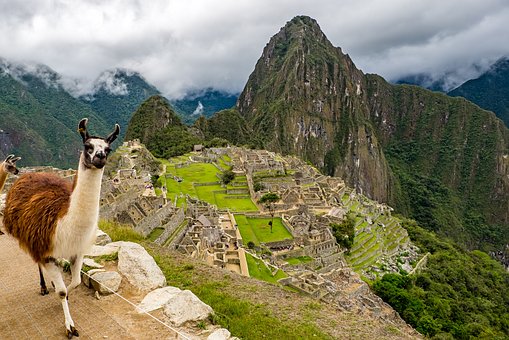
Three hours later we came
across a few huts (Santa Rosa settlement) and rested with one of the owners.
We stayed for a while, tired and soaking up the sunny afternoon with our
numbed brains. Could have stayed there forever. Then another 2 hours of
grunt-work ascent and we break the gradient – finally there, on a flat
top. Looking back at the thin silver string of the river down in the valley,
I couldn’t believe we got so far.
There were a couple of huts
at the top. We camped outside the house of the local bear hunter, an amazing
guy full of life. He warmly welcomed us to his wife’s cooking. The reason
he is so happy is because from his porch you can see the most beautiful
sunset panorama on the planet.
Next morning we got our first
sighting of Choquequirao just a few steps from the settlement. But it took
another one and a half hours of beating the trail to get there. We dived
into the woods, stepped out of a bush and there we were – on the terraces
of the Lost City, just like that. No gates, no tickets, not a soul.
Choquequirao was the jewel
of my trip. Sure, Machu Picchu is gorgeous and if you are looking for convenience,
you can be there and back in one day. Choquequirao takes 4 days of hard
walking and that is why it is so serene, challenging, profound and rewarding.
It is a true Lost City.
You get back the same way
you came. For me, the journey to Choquequirao was the first leg of the
7-day trek over the mountains to Machu Picchu (if you wanted to know whether
that could be done). But that’s another story.
Notes
This trek took place in August
2002. There have been some changes, although minor. The entry to Choquequirao
is now purchased at 10 soles, this lasts you as long as you want. The camping
on the terrace now includes toilets and an emergency line with Cachora.
The destination is also getting more popular, although still far from crowded:
in the high season of July / August 2005 there were an average of 50 visitors
on site plus about the same number en route at any time. Hurry before they
build a railway! The trek can be completed in 4 days if needed, but you
only get 1 hour on site: you carry on straight to Choquequirao on your
2nd day, have a tour in the morning and set off, arriving to the Apurimac
river crossing by night. For any treks to Choquequirao make sure you have
adequate footwear and you are accustomed to the altitude: that second day
will get you sweating and your ankles twisting.
-----------------------
Alex is the webmaster of
Valencia
Tourist Information - an independent resource on travelling in Valencia,
Spain.
Top
|

